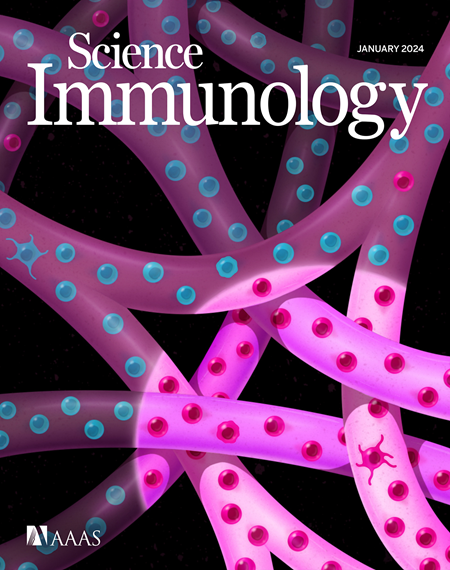T-B细胞在异位淋巴滤泡中的合作促进中枢神经系统自身免疫
IF 17.6
1区 医学
Q1 IMMUNOLOGY
引用次数: 0
摘要
脑膜异位淋巴滤泡(eLF)样结构在多发性硬化症中有描述,但其在中枢神经系统自身免疫中的作用尚不清楚。在这里,我们使用了以elf形成为特征的T辅助细胞17 (th17)过继性转移实验性自身免疫性脑脊髓炎模型。单细胞RNA测序显示,活化的B细胞簇和B1/边缘带样B细胞在中枢神经系统中过量存在,并鉴定了在中枢神经系统中进行生发中心反应和克隆扩增的B细胞。通过活体成像直接观察ht17 - B细胞的相互作用,我们证明了T细胞和B细胞在脑膜上皮细胞中形成持久的抗原特异性接触,从而导致自身反应性T细胞的再激活。中枢神经系统T细胞依赖中枢神经系统B细胞维持促炎细胞因子。我们的研究表明,广泛的T - B细胞合作发生在脑膜上皮细胞中,促进B细胞分化和T细胞再激活,并可能因此在中枢神经系统中传播阴燃炎症。本文章由计算机程序翻译,如有差异,请以英文原文为准。
T–B cell cooperation in ectopic lymphoid follicles propagates CNS autoimmunity
Meningeal ectopic lymphoid follicle (eLF)–like structures have been described in multiple sclerosis, but their role in central nervous system (CNS) autoimmunity is unclear. Here, we used a T helper 17 (TH17) adoptive transfer experimental autoimmune encephalomyelitis model featuring formation of eLFs. Single-cell RNA sequencing revealed that clusters of activated B cells and B1/marginal zone–like B cells were overrepresented in the CNS and identified B cells poised for undergoing germinal center reactions and clonal expansion in the CNS. Using intravital imaging to directly visualize TH17–B cell interactions, we demonstrated that T and B cells form long-lasting antigen-specific contacts in meningeal eLFs that result in reactivation of autoreactive T cells. CNS T cells depended on CNS B cells to maintain a proinflammatory cytokine profile. Our study reveals that extensive T–B cell cooperation occurs in meningeal eLFs, promoting both B cell differentiation and T cell reactivation, and may thereby propagate smoldering inflammation in the CNS.
求助全文
通过发布文献求助,成功后即可免费获取论文全文。
去求助
来源期刊

Science Immunology
Immunology and Microbiology-Immunology
CiteScore
32.90
自引率
2.00%
发文量
183
期刊介绍:
Science Immunology is a peer-reviewed journal that publishes original research articles in the field of immunology. The journal encourages the submission of research findings from all areas of immunology, including studies on innate and adaptive immunity, immune cell development and differentiation, immunogenomics, systems immunology, structural immunology, antigen presentation, immunometabolism, and mucosal immunology. Additionally, the journal covers research on immune contributions to health and disease, such as host defense, inflammation, cancer immunology, autoimmunity, allergy, transplantation, and immunodeficiency. Science Immunology maintains the same high-quality standard as other journals in the Science family and aims to facilitate understanding of the immune system by showcasing innovative advances in immunology research from all organisms and model systems, including humans.
 求助内容:
求助内容: 应助结果提醒方式:
应助结果提醒方式:


